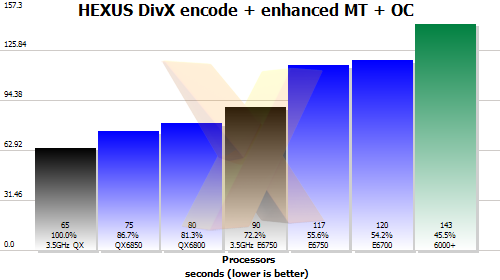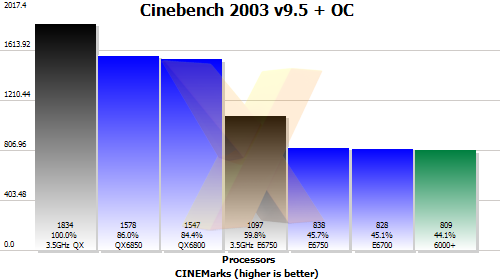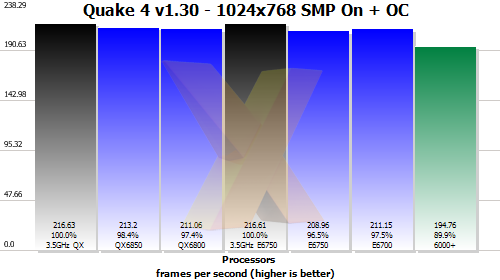Overclocking and power consumption
Of course, when you have the fastest CPU on the market there's only one sensible thing to do - see if you can make it even faster!
Each Core 2 Extreme processors has an unlocked multiplier, so we thought we'd knock things up a notch, increasing the QX6850's multiplier to 10x. We were going to turn it up to 11 but a harshly-worded cease-and-desist order scuppered that plan.
The increased multiplier combined with a slight increase in front-side bus speed - up to 350.1MHz (1400.3MHz QDR) from 333MHz (1333MHz QDR) - yielded a maximum stable overclock of 3501.3MHz.
And this was using the stock cooler from a QX6700, not even the QX6850's standard cooler. We have no doubt that a more-efficient cooler would allow even higher performance.
However, those of you without Extreme budgets will find yourselves stuck with lower multipliers. For the E6850, this means between 6x and 8x - and that could prove limiting for some people.
We were able to push the E6750 up to 3503.2MHz. That involved setting the front-side bus all the way up at 437.9MHz (1751.6MHz QDR) - compared to the default of 333MHz (1333MHz QDR) - and increasing voltage from the 1.3V default up to 1.35V. Anything more produced instability.
But this could have been a case of hitting the limits of the MSI P35 Platinum motherboard, rather than down to the CPU itself. It would have been instructive to have tried using one of the motherboards we know can be pushed hard, such as the ASUS P5K Deluxe.


DivX and CINEBENCH both see a dramatic increase in performance when we overclocked the two Intel processors. DivX on the overclocked E6750 was significantly faster, taking 27 seconds off the stock time and coming within 10 seconds of the QX6800.
CINEBENCH, with its superior multi-core scaling, is less kind to the overclocked E6750 but resulted in 1834 CINEMarks for the overclocked QX6850 - the highest score seen so far in the HEXUS labs.

In contrast, with Quake 4, which is predominantly limited by the GPU, all the CPU power in the world is still going to make little difference.
Power consumption
Intel claims the same 130W TDP across the board for all Core 2 Extreme quad-core parts. Likewise all Core 2 Duo E6000-series processors are rated at 65W TDP.
Power-consumption figures are taken for the entire system from the power socket and then adjusted to account for the efficiency of the power supply, in this case 82 per cent.
Peak load is taken by running 3DMark05, at 1920x1200 4xAA 8xAF, alongside enough instances of the Prime95 torture test to fully load all remaining cores. Therefore please remember these are not power figures for just the CPU but for a complete, high-end, PC.

Incredibly, our testing shows the power consumption of the Core 2 Extreme QX6850 to be 5W lower at idle and 11W lower at full load than the slower-speed QX6800. It also beats the Athlon 64 X2 6000+ at full load and is mere 1W higher at idle, suggesting that the G0 stepping is working well.
Similarly, the E6750 turns in considerably lower (better) results than the 6000+ at idle and peak load, all the while offering faster performance.
And, it needs to be noted that all this occurs despite the new CPUs having an increased front-side bus speed of 333MHz that sees them idling at 2GHz, rather than the 1.6GHz of the older 266MHz models.









